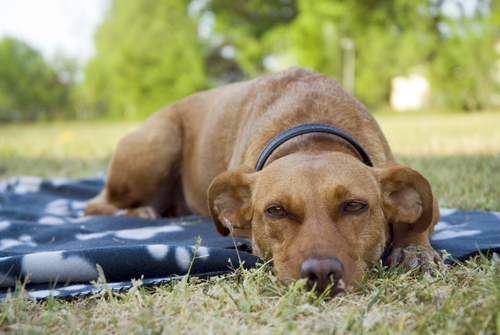How to Lower a Dog's Fever

Fever is a common problem among dogs. Just like humans, they have an average temperature between 38ºC and 39.2ºC, which is normal when healthy. Any temperature above this level can be a sign of a virus or illness.
We know how to lower the fever of a child, an adult, and even ourselves. So, how do we lower a dog’s temperature? We’re going to look at various ways to do it.
How to detect if your animal has a fever
Sometimes animals do not show any signs that something is bothering them. Since we are not touching our pet 24 hours a day to see if something is wrong, how do we know if our friend has a high temperature?
Even unconsciously, he will give signs if something is not right. The following are some examples:

- He is sleepy. He looks like a living dead dog even when he has rested well at night.
- Depressed. If he looks sad, don’t overlook it. It’s possible that he has a fever.
- Shivers. If he has small and constant convulsions, it’s possible that a fever or an infection are causing them.
- Weakness.
- Rapid heart rate.
- Rapid breathing.
- Cough.
- Dehydration.
- Vomiting.
All of these could be symptoms that your dog has a fever and that you have to do something to control it. If you have already identified it, it’s normal to wonder how to make it go down. Now we are going to talk about that.
How do you make a dog’s fever go down?
Even though fever is not always a symptom of a grave illness, it is important to keep it in its normal state. You want to prevent causing more problems for your animal. Let’s see how you can do it:
- If your dog has other symptoms besides a rise in temperature, the best thing to do is go to the veterinarian. The fever could be an indication of something more serious. If you think that it’s only a rise in temperature, you can follow other steps. Although if you prefer to have peace of mind, the veterinarian is the best option.
- Just as with people, cold water is a good option. Since dogs are not usually water lovers, how can you do this? First, look for a place where the animal feels relaxed. Wrap him in a damp towel, and let him be for a few minutes so that he gets used to the cold water. Afterwards, dry him with a towel.

- If your dog does not tolerate being wrapped in a towel, you can always wet a sponge and go over the hottest parts of the animal.These are normally the snout, the underarms, and the groin. After don’t forget to dry the parts that were wet. You can use a hairdryer on the cold setting.
- Give the animal cold water to drink so that the animal’s body acclimates and cools down. Move his bed and look for a cool place to put it. Outside is a good option if it’s nighttime and not too cold.
- Bathing him with cold water for ten minutes is another option. Later you will have to dry him with cold air. Never use hot air because that will only make things worse. Don’t exceed the time or it could have negative consequences.
- Placing bags of ice between the back legs and/or on his head is a good way to lower a fever. However, remember that the animal should not be wet for a long time and that you should always dry the areas that got wet.
- If after trying one of all of these remedies, the animal’s fever does not go down and 24 hours have passed, you must go to the veterinarian immediately. Something more serious and less noticeable is probably happening.
Fever is a common problem among dogs. Just like humans, they have an average temperature between 38ºC and 39.2ºC, which is normal when healthy. Any temperature above this level can be a sign of a virus or illness.
We know how to lower the fever of a child, an adult, and even ourselves. So, how do we lower a dog’s temperature? We’re going to look at various ways to do it.
How to detect if your animal has a fever
Sometimes animals do not show any signs that something is bothering them. Since we are not touching our pet 24 hours a day to see if something is wrong, how do we know if our friend has a high temperature?
Even unconsciously, he will give signs if something is not right. The following are some examples:

- He is sleepy. He looks like a living dead dog even when he has rested well at night.
- Depressed. If he looks sad, don’t overlook it. It’s possible that he has a fever.
- Shivers. If he has small and constant convulsions, it’s possible that a fever or an infection are causing them.
- Weakness.
- Rapid heart rate.
- Rapid breathing.
- Cough.
- Dehydration.
- Vomiting.
All of these could be symptoms that your dog has a fever and that you have to do something to control it. If you have already identified it, it’s normal to wonder how to make it go down. Now we are going to talk about that.
How do you make a dog’s fever go down?
Even though fever is not always a symptom of a grave illness, it is important to keep it in its normal state. You want to prevent causing more problems for your animal. Let’s see how you can do it:
- If your dog has other symptoms besides a rise in temperature, the best thing to do is go to the veterinarian. The fever could be an indication of something more serious. If you think that it’s only a rise in temperature, you can follow other steps. Although if you prefer to have peace of mind, the veterinarian is the best option.
- Just as with people, cold water is a good option. Since dogs are not usually water lovers, how can you do this? First, look for a place where the animal feels relaxed. Wrap him in a damp towel, and let him be for a few minutes so that he gets used to the cold water. Afterwards, dry him with a towel.

- If your dog does not tolerate being wrapped in a towel, you can always wet a sponge and go over the hottest parts of the animal.These are normally the snout, the underarms, and the groin. After don’t forget to dry the parts that were wet. You can use a hairdryer on the cold setting.
- Give the animal cold water to drink so that the animal’s body acclimates and cools down. Move his bed and look for a cool place to put it. Outside is a good option if it’s nighttime and not too cold.
- Bathing him with cold water for ten minutes is another option. Later you will have to dry him with cold air. Never use hot air because that will only make things worse. Don’t exceed the time or it could have negative consequences.
- Placing bags of ice between the back legs and/or on his head is a good way to lower a fever. However, remember that the animal should not be wet for a long time and that you should always dry the areas that got wet.
- If after trying one of all of these remedies, the animal’s fever does not go down and 24 hours have passed, you must go to the veterinarian immediately. Something more serious and less noticeable is probably happening.
This text is provided for informational purposes only and does not replace consultation with a professional. If in doubt, consult your specialist.








